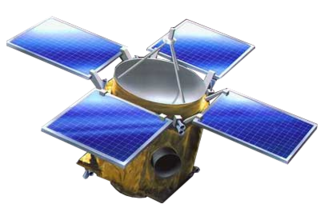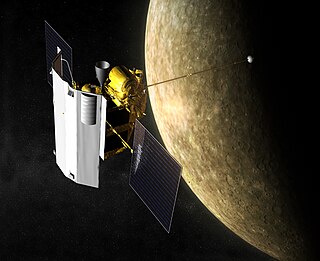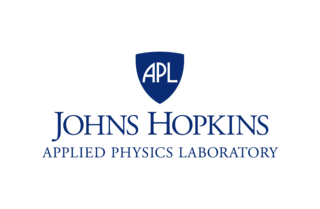Related Research Articles

Near Earth Asteroid Rendezvous – Shoemaker, renamed after its 1996 launch in honor of planetary scientist Eugene Shoemaker, was a robotic space probe designed by the Johns Hopkins University Applied Physics Laboratory for NASA to study the near-Earth asteroid Eros from close orbit over a period of a year. It was the first spacecraft to orbit an asteroid and land on it successfully. In February 2000, the mission closed in on the asteroid and orbited it. On February 12, 2001, Shoemaker touched down on the asteroid and was terminated just over two weeks later.

MESSENGER was a NASA robotic space probe that orbited the planet Mercury between 2011 and 2015, studying Mercury's chemical composition, geology, and magnetic field. The name is a backronym for "Mercury Surface, Space Environment, Geochemistry, and Ranging", and a reference to the messenger god Mercury from Roman mythology.

The Discovery Program is a series of Solar System exploration missions funded by the U.S. National Aeronautics and Space Administration (NASA) through its Planetary Missions Program Office. The cost of each mission is capped at a lower level than missions from NASA's New Frontiers or Flagship Programs. As a result, Discovery missions tend to be more focused on a specific scientific goal rather than serving a general purpose.
Ben J. Bussey is an American planetary scientist.

The geology of Mercury is the scientific study of the surface, crust, and interior of the planet Mercury. It emphasizes the composition, structure, history, and physical processes that shape the planet. It is analogous to the field of terrestrial geology. In planetary science, the term geology is used in its broadest sense to mean the study of the solid parts of planets and moons. The term incorporates aspects of geophysics, geochemistry, mineralogy, geodesy, and cartography.

The Johns Hopkins University Applied Physics Laboratory is a not-for-profit university-affiliated research center (UARC) in Howard County, Maryland. It is affiliated with Johns Hopkins University and employs 8,700 people as of 2024. APL is the nation's largest UARC.

Dante S. Lauretta is a professor of planetary science and cosmochemistry at the University of Arizona's Lunar and Planetary Laboratory. He is the principal investigator on NASA's OSIRIS-REx mission.

Maria T. Zuber is an American geophysicist who is the vice president for research at the Massachusetts Institute of Technology, where she also holds the position of the E. A. Griswold Professor of Geophysics in the Department of Earth, Atmospheric and Planetary Sciences. Zuber has been involved in more than half a dozen NASA planetary missions aimed at mapping the Moon, Mars, Mercury, and several asteroids. She was the principal investigator for the Gravity Recovery and Interior Laboratory (GRAIL) Mission, which was managed by NASA's Jet Propulsion Laboratory.

Louise Prockter is a planetary scientist and former supervisor of the Planetary Exploration Group at the Johns Hopkins University's Applied Physics Laboratory. In 2016 the Universities Space Research Association (USRA) announced the appointment of Prockter as Director of the Lunar and Planetary Institute (LPI) in Houston, Texas, effective September 6, 2016. She was the first woman to serve as LPI Director and led the LPI from 2016 to 2020. She is currently Chief Scientist, Space Exploration Sector, at the Johns Hopkins University Applied Physics Laboratory.
Elizabeth "Zibi" Turtle is a planetary scientist at the Johns Hopkins University Applied Physics Laboratory.

Double Asteroid Redirection Test (DART) was a NASA space mission aimed at testing a method of planetary defense against near-Earth objects (NEOs). It was designed to assess how much a spacecraft impact deflects an asteroid through its transfer of momentum when hitting the asteroid head-on. The selected target asteroid, Dimorphos, is a minor-planet moon of the asteroid Didymos; neither asteroid poses an impact threat to Earth, but their joint characteristics made them an ideal benchmarking target. Launched on 24 November 2021, the DART spacecraft successfully collided with Dimorphos on 26 September 2022 at 23:14 UTC about 11 million kilometers from Earth. The collision shortened Dimorphos' orbit by 32 minutes, greatly in excess of the pre-defined success threshold of 73 seconds. DART's success in deflecting Dimorphos was due to the momentum transfer associated with the recoil of the ejected debris, which was substantially larger than that caused by the impact itself.

The Planetary Missions Program Office is a division of NASA headquartered at the Marshall Space Flight Center, formed by the agency's Science Mission Directorate (SMD). Succeeding the Discovery and New Frontiers Program Office, it was established in 2014 to manage the Discovery and New Frontiers programs of low and medium-cost missions by third-party institutions, and the Solar System Exploration program of NASA-led missions that focus on prioritized planetary science objectives. The Discovery and New Frontiers programs were established in 1992 and 2001 respectively, and have launched fourteen primary missions together, along with two missions launched under the administration of the Planetary Missions Program Office. The Solar System Exploration Program was established alongside the office, with three missions planned for launch under the new program.

Jani Radebaugh is an American planetary scientist and professor of geology at Brigham Young University who specializes in field studies of planets. Radebaugh's research focuses on Saturn's moon Titan, Jupiter's moon Io, the Earth's Moon, Mars and Pluto. Radebaugh is a Science Team member of the Dragonfly mission to Titan, the IVO Io mission proposal, and the Mars Median project. She was an Associate Team Member of the Cassini-Huygens RADAR instrument from 2008 to 2017, and was a graduate student scientist for Io for the Galileo mission. She does science outreach through her work as an expert contributor to the Science/Discovery program How the Universe Works and other television and radio programs. In December 2012, Radebaugh and her colleagues on the Cassini mission announced the discovery of Vid Flumina, a liquid methane river on Saturn's moon Titan over 320 km (200 mi) long and resembling the Nile river.

Barbara Cohen is a planetary scientist at NASA's Goddard Space Flight Center. The asteroid 6816 Barbcohen is named after her.

Faith Vilas is an American planetary scientist and Director of the MMT Observatory in Arizona.
MANTIS is a mission concept that would flyby 14 asteroids covering a wide range of types and masses, and obtaining remote sensing and in-situ data. This mission would explore the diversity of asteroids to understand the Solar system's history, its present processes, and hazards. The concept was proposed in 2019 to NASA's Discovery Program to compete for funding and development.

Brett W. Denevi is a Planetary Geologist at the Johns Hopkins University Applied Physics Laboratory. She is currently serving as the Deputy Principal Investigator for the Lunar Reconnaissance Orbiter Camera. In 2014, Asteroid 9026 was named Denevi in her honor. She is the recipient of seven NASA group achievement awards and in 2014 she was awarded a NASA Early Career Fellowship. In 2015, she received a Maryland Academy of Sciences Outstanding Young Scientist Award.

Katherine Helen Joy is a Professor in Earth Sciences at the University of Manchester. Joy has studied lunar samples from the Apollo program as part of her research on meteorites and lunar science.

Light Italian CubeSat for Imaging of Asteroids is a six-unit CubeSat of the Italian Space Agency (ASI). LICIACube is a part of the Double Asteroid Redirection Test (DART) mission and carries out observational analysis of the Didymos asteroid binary system after DART's impact on Dimorphos. It communicates directly with Earth, sending back images of the ejecta and plume of DART's impact as well as having done asteroidal study during its flyby of the Didymos system from a distance of 56.7 km (35.2 mi), 165 seconds after DART's impact. LICIACube is the first purely Italian autonomous spacecraft in deep space. Data archiving and processing is managed by the Space Science Data Center (SSDC) of the ASI.

Hera is a space mission in development at the European Space Agency in its Space Safety program. Its primary objective is to study the Didymos binary asteroid system that was impacted by DART and contribute to validation of the kinetic impact method to deviate a near-Earth asteroid in a colliding trajectory with Earth. It will measure the size and the morphology of the crater created by and momentum transferred by an artificial projectile impacting an asteroid, which will allow measuring the efficiency of the deflection produced by the impact. It will also analyze the expanding debris cloud caused by the impact.
References
- 1 2 3 Chabot, Nancy. "JHUAPL - , Nancy, Chabot - Science Research Portal". secwww.jhuapl.edu. Retrieved 2017-10-10.
- ↑ Chabot, Nancy. "Geochemical studies of the cores of terrestrial planetary bodies" . Retrieved 2024-03-29.
- ↑ "MESSENGER Biographies". Archived from the original on 2014-02-21.
- ↑ "1,000th Featured Image from MESSENGER Posted on the Project's Web Gallery". Archived from the original on 2014-02-21.
- ↑ Bardan, Roxana (2022-10-11). "NASA Confirms DART Mission Impact Changed Asteroid's Motion in Space". NASA. Retrieved 2022-12-21.